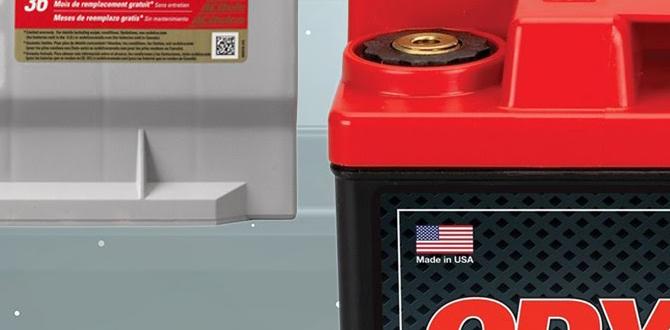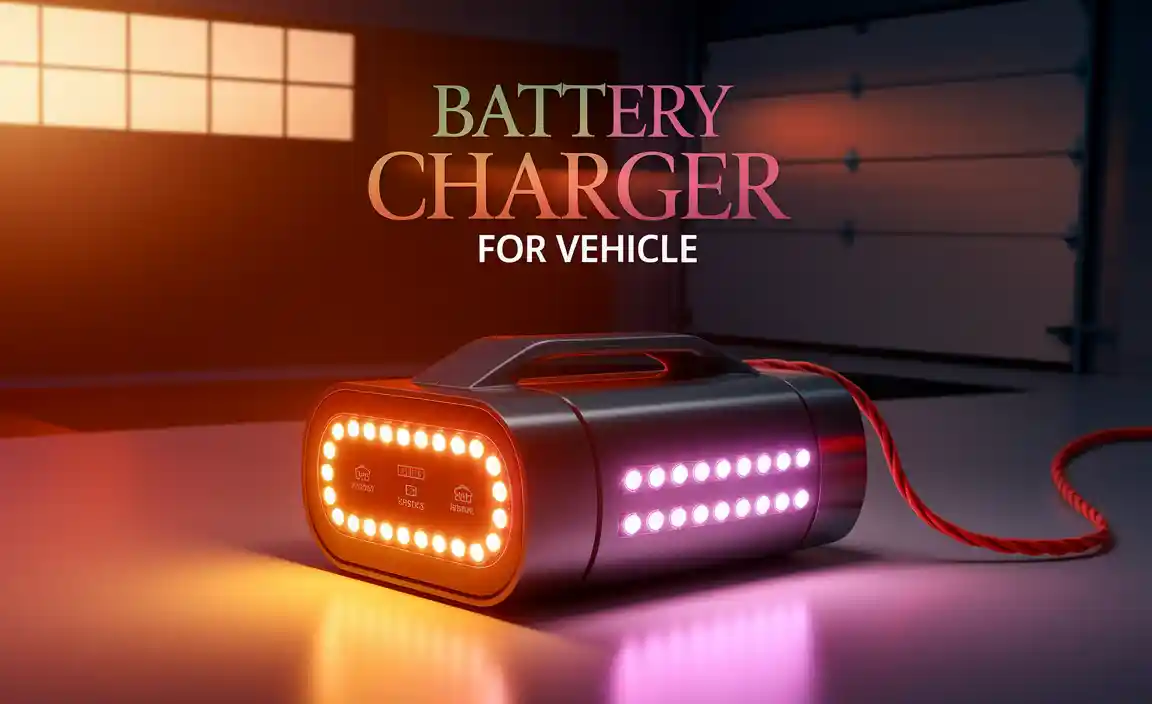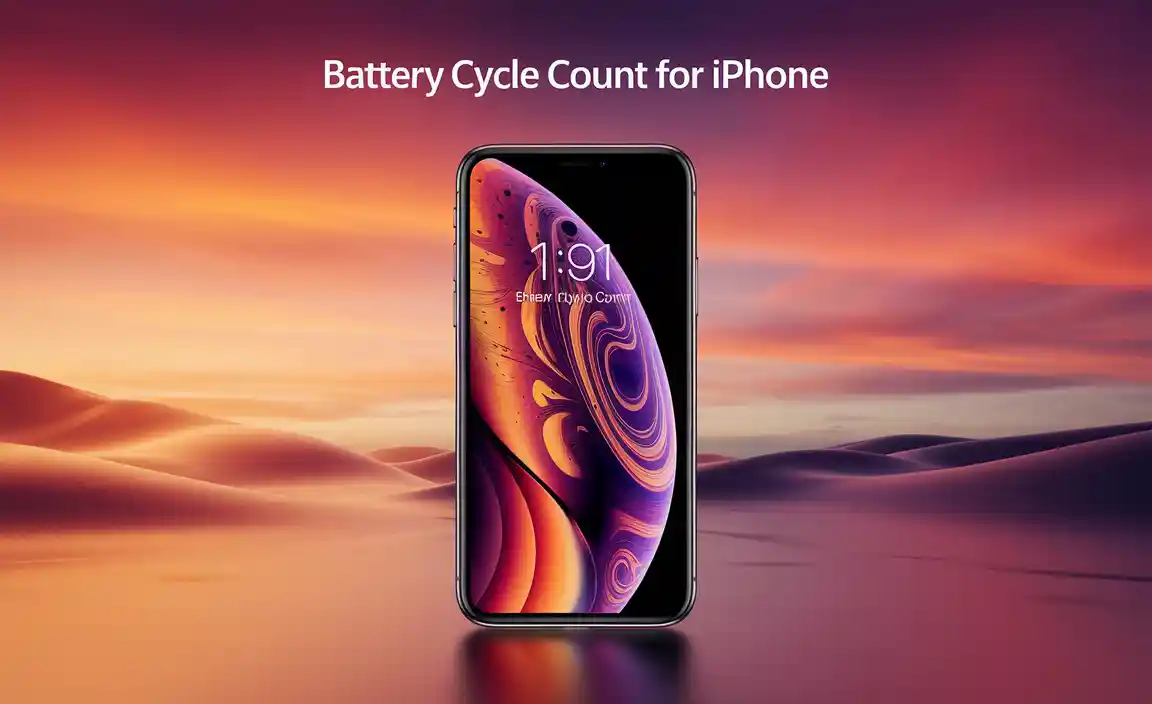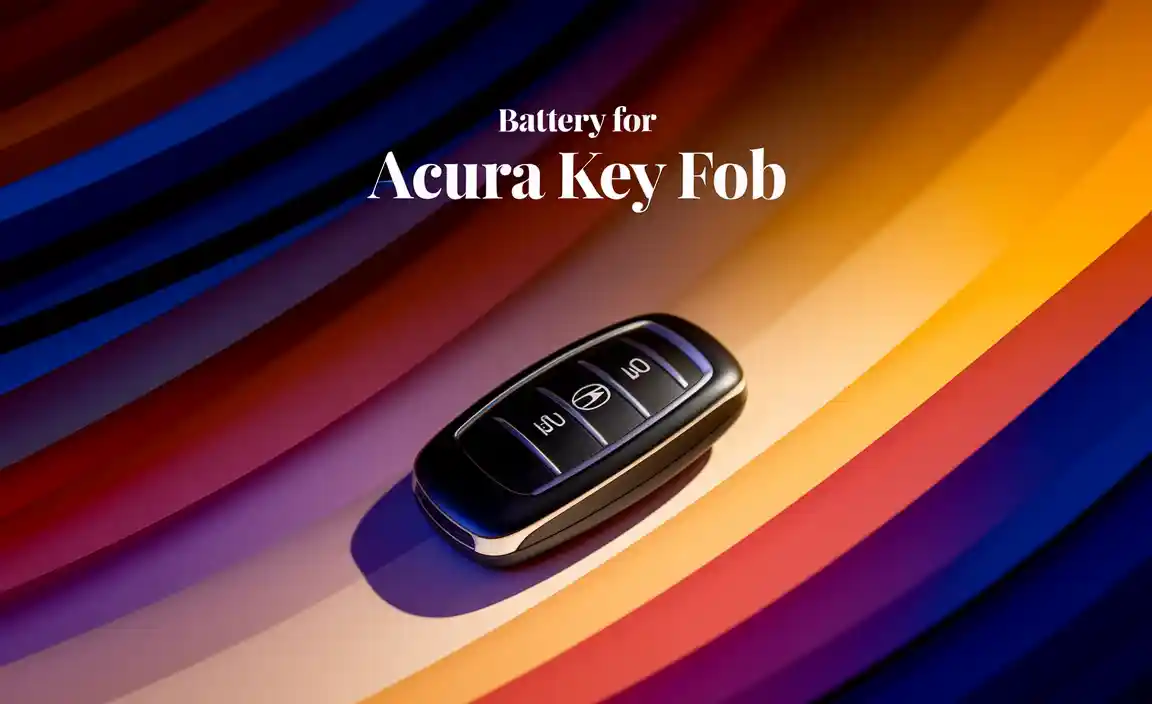Choosing the right battery for your car can feel tricky. Many drivers wonder, “What type of battery for my car is best?” This question is important, especially if you’re dealing with a dead battery. Imagine being stranded on a cold morning because your car won’t start. It’s a hassle no one wants to face!
Did you know that not all car batteries are the same? There are different types, each made for specific needs. For example, some batteries are better for cold weather, while others work well in heat. Understanding these differences is key to picking the right one for your car.
This article will help you learn what type of battery for your car suits you best. From lead-acid to lithium, we’ll cover the options and their benefits. Get ready to unlock the secrets of car batteries and keep your vehicle running smoothly!
What Type Of Battery For My Car: Choosing The Right One

What Type of Battery for My Car
Choosing the right car battery can be confusing. Many factors like vehicle type and climate matter. Most cars need either lead-acid or AGM batteries. Did you know that cold weather can drain batteries faster? Check your owner’s manual for exact specifications. When in doubt, ask a trusted mechanic. A good battery keeps your car running smoothly, so don’t overlook this important choice!Understanding Car Battery Basics
Types of car batteries: LeadAcid, AGM, Lithiumion. Importance of battery specifications: CCA, RC, and capacity ratings.Understanding your car’s battery helps keep your vehicle running smoothly. There are three main types: Lead-Acid, known for its affordability; AGM (Absorbent Glass Mat), which are great for modern cars; and Lithium-ion, popular in electric vehicles. Key battery specs include CCA (Cold Cranking Amps), RC (Reserve Capacity), and capacity ratings, all crucial for choosing the right battery. Think of CCA like a strength test: how well can your battery wake up your car on frosty mornings? Here’s a quick comparison:
| Battery Type | Advantages | Disadvantages |
|---|---|---|
| Lead-Acid | Cheap, widely available | Heavy, shorter lifespan |
| AGM | Durable, vibration-resistant | More expensive |
| Lithium-ion | Lightweight, fast charging | Very costly |
Choosing the right battery makes all the difference! Remember, a well-chosen battery can save you from surprise trips to the mechanic.
Factors to Consider When Choosing a Car Battery
Vehicle type and size: Compatibility considerations. Climate conditions: Impact on battery performance.Choosing a car battery? Think about your vehicle’s type and size first. Different cars need different batteries, kind of like how a goldfish needs a bowl and a lion needs a jungle! Also, consider your local climate. Hot summers or freezing winters can really affect battery performance. Batteries work best at certain temperatures, so watch the weather! Below is a quick guide to help you out:
| Climate Condition | Battery Type |
|---|---|
| Hot Weather | Flooded Lead-Acid |
| Cold Weather | AGM (Absorbent Glass Mat) |
Remember, picking the right battery ensures your car runs smoothly. Like picking the perfect cookie for a snack, it’s all about compatibility!
Common Car Battery Types
Conventional LeadAcid Batteries: Pros and cons. AGM Batteries: Features and benefits. Gel Batteries: Applications and limitations.There are different types of car batteries. Each has its own strengths and weaknesses. Conventional lead-acid batteries are popular. They are affordable and easily found. However, they can spill and need regular maintenance. AGM batteries are stronger and safer. They work well for modern cars. They last longer and need less upkeep. Lastly, gel batteries are useful in special situations. They don’t spill, but they can be pricey and may not fit all cars.
What is the best battery type for my car?
The best battery type depends on your car’s needs. Lead-acid batteries work for many vehicles. AGM batteries are great for high-performance needs. Always check what fits your car.
How to Determine the Right Battery Size
Using your vehicle’s manual: Identifying recommended battery sizes. Standard battery group sizes: What they mean.Choosing the correct battery size for your car is vital for smooth driving. Start by checking your vehicle’s manual. It lists the recommended battery sizes. Standard battery group sizes also matter. These sizes tell you how powerful the battery is and if it fits in your car. Here’s a quick guide:
- Group Size 24: Common in many cars.
- Group Size 35: Often used in smaller vehicles.
- Group Size 78: Great for larger cars and trucks.
What is a standard battery group size?
A standard battery group size is a code that shows the dimensions and power of a battery. It helps you find the right fit for your car.Battery Brands to Consider
Top automotive battery brands: Durability and warranty comparisons. Specialty batteries: For performance and electric vehicles.Choosing the right battery can be tricky! Some top brands stand out for their durability and warranties. Brands like Optima and DieHard offer great longevity. Their warranties often cover 3 to 5 years, so you won’t be stranded for long! If you’re into speed or have an electric car, consider Trojan or ACDelco. They’re made for performance! Here’s a quick look:
| Brand | Durability | Warranty |
|---|---|---|
| Optima | Long-lasting | 3 – 5 years |
| DieHard | Reliable | 3 – 4 years |
| Trojan | Performance-ready | 2 – 3 years |
| ACDelco | Specialty | 2 – 5 years |
Remember, a good battery is like a trusty sidekick—it just makes everything better!
Signs Your Car Needs a New Battery
Warning indicators: Dashboard lights and physical symptoms. Testing and diagnostics: Tools for evaluating battery health.It’s important to watch for signs that your car might need a new battery. Keep an eye on your dashboard lights. If you see a battery or check engine light, it may be time for a replacement. Physical signs like a slow engine crank or corrosion on battery terminals also indicate issues.
To evaluate battery health, tools like a multimeter are helpful. A multimeter can test voltage levels. Visit a mechanic if you’re unsure about testing.
How can I know if my battery is failing?
You can look for warning lights and slow starts as clues of battery failure. If your car struggles to start or the dashboard lights flicker, it’s time to get it checked.
Installation and Maintenance Tips
Proper installation: Stepbystep guide. Maintenance practices to extend battery life: Regular checks and caring tips.To install a car battery, start by gathering your tools: you’ll need gloves, a wrench, and maybe a snack for energy! First, turn off the engine and open the hood. Next, remove the negative cable (that’s the black one) before the positive cable (the red one). Then, take out the old battery. Place the new one in, connecting the positive cable first and the negative last. Remember, the battery doesn’t bite, but it does have some serious zap!
For keeping your battery happy, check it regularly. Look for corrosion on the terminals; it’s like battery dandruff! Clean it using a mix of baking soda and water. Keep the battery terminals tight, and check the fluid levels if it’s not sealed. A little love can add life to your battery—like giving a plant water instead of letting it wilt!
| Maintenance Tips | Frequency |
|---|---|
| Check terminals for corrosion | Every month |
| Inspect fluid levels | Every three months |
| Clean battery | As needed |
With these steps, you’ll keep your battery in great shape. Think of it as giving your car a daily hug!
Recycling and Disposal of Old Batteries
Importance of recycling: Environmental impact. How to dispose of car batteries safely: Local regulations and options.Old batteries are like stubborn guests who won’t leave the party. It’s crucial to recycle them, as improper disposal harms our planet. Recycling batteries helps prevent toxic chemicals from polluting soil and water. When it’s time to say goodbye to your car battery, check local rules. Many places offer drop-off sites or collection events. Be sure to follow safety guidelines—your future self will thank you!
| Disposal Option | Description |
|---|---|
| Drop-off Centers | Locations where you can safely leave your old batteries. |
| Retail Take-Back | Many auto shops accept used batteries for recycling. |
| Local Events | Check for community recycling days to drop off batteries. |
Conclusion
In summary, choosing the right battery for your car is crucial for performance. Consider factors like size, type, and weather conditions. Research options and read your car’s manual for specific requirements. Visit a local shop or online resources for help. By understanding your needs, you can make an informed choice that keeps your car running smoothly. Let’s get started!FAQs
Sure! Here Are Five Related Questions On The Topic Of Car Batteries:Sure! Here are five questions about car batteries: 1. **What does a car battery do?** A car battery gives power to start the engine and run other electrical parts, like lights. 2. **How do you know if a car battery is dead?** If your car won’t start and the lights are dim, the battery might be dead. 3. **How can you take care of a car battery?** You can keep it clean and check the water level. This helps it work better and last longer. 4. **What happens if you jump-start a car?** Jump-starting gives the dead battery power from another battery so the car can start again. 5. **How long does a car battery last?** Most car batteries last about 3 to 5 years. Be sure to check yours regularly!
Sure! Just give me the question you would like me to answer, and I’ll be happy to help!
What Are The Different Types Of Batteries Commonly Used In Cars, And How Do They Differ?Cars usually use two main types of batteries: lead-acid batteries and lithium-ion batteries. Lead-acid batteries are common in most cars. They are heavier and cheaper but don’t last as long. Lithium-ion batteries are lighter and keep cars running longer. They are found in electric cars, making them more modern and efficient.
How Do I Determine The Correct Size And Specifications For A Replacement Battery For My Vehicle?To find the right battery for your car, check the owner’s manual. It tells you the size and type you need. You can also look at the old battery’s label. Make sure the new battery has the same size, power, and connections. If you’re unsure, ask an adult or a store worker for help.
What Factors Should I Consider When Choosing A Battery For Driving In Extreme Weather Conditions?When you pick a battery for driving in really hot or cold weather, think about the temperature range it can handle. Look for a battery that works well in both hot and cold. Check how long it lasts, especially if it’s very cold outside. You also want a battery that charges quickly so you can drive without waiting too long. Finally, read reviews to see what other drivers say about using it in harsh weather.
How Can I Extend The Lifespan Of My Car Battery, And What Maintenance Steps Should I Follow?To extend your car battery’s lifespan, keep it clean and check for corrosion, which looks like white or green stuff on the terminals. Make sure all connections are tight. You should also drive your car regularly to keep the battery charged. In cold weather, park your car in a garage if you can. Finally, have your battery tested every few years to see if it needs replacing.
What Are The Signs That My Car Battery Is Failing And Needs To Be Replaced?You might notice a few signs when your car battery is failing. If your car takes longer to start, it could be the battery. You may also see dim lights or hear clicking sounds. If you smell something strange or see leaks, it’s time to check the battery. It’s important to get it looked at soon!







